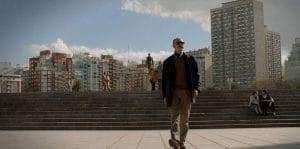
It’s hard to tell at the beginning of Rojo where it’s going, or even what kind of story it will be. We know it’s 1975 in a small town in Argentina, and we know there’s an abandoned house that will be of interest. Then we meet Claudio (Dario Grandinetti), a lawyer, big fish in a small pond. There’s a dust-up with a man at a restaurant who tries to take Claudio’s table and is eventually dragged out screaming about Nazis by the other patrons. Later that night events transpire that will haunt Claudio and leave a dead body in the desert outside town. This dramatic beginning, however, is only tangentially related to the activities at the heart of the film.
Claudio has a nice life, loves his wife Susana (Andrea Frigerio), enjoys his family, and his prestige in the town. He seems like a stand-up guy, no more or less corrupt than anyone else around and dips into some shady real-estate deals. Unexpectedly he finds himself embroiled in an investigation when a famous Chilean TV detective named Sinclair (Alfredo Castro) arrives to look into the mysterious disappearance of a young man, a newcomer to the town. Sinclair seems suspicious of Claudio, who tries desperately to keep his secrets, and all this, too, is not the theme of the film.
While Claudio frets, bobs, and weaves, hoping to stay out of trouble, news from the wider world seeps in that a Federal Interventor will be sent to the town.
President Juan Perón has just died, his wife Isabel Perón is now running the country, which is in chaos. A military junta takeover is in progress, and by March of 1976, it was a fait accompli, replacing Eva Perón with General Jorge Rafael Videla. Peron’s government was corrupt, but the ramp-up to replacing him was so insidious and violent; it is now known as the “dirty war.” Rojo is a glimpse of everyday life during the wild political turmoil, and how subtle the erosion of checks and balances can be. This, of course, in 2019, is a note we in the U.S. should take heed. Life in the unnamed town is swept along in the avalanche of these events, but day by day the changes are not as startling as the images on the national news broadcasts.

“…Sinclair seems suspicious of Claudio, who tries desperately to keep his own secrets…”
Dario Grandinetti, noteworthy for Almodovar’s Julieta and Talk to Her, plays Claudio as a perfect 70’s film character, in keeping with the film’s stylistic bent. His large mustache enters the room before he does, the picture of South American machismo.
Rojo is delightfully multi-layered and complex, conveying more in what is not said than with anything overt. Symbolism and hidden meanings abound, from the title (“red” being the American word for “communism” in the ’70s) to all the people who vanish during the course of the film. Disappearances were a significant tactic of the dirty war, by the time the junta leaders had relinquished power in 1983, 30,000 people were gone without a trace.
Benjamin Naishtat directs with a steady hand and a strong vision. Pedro Sotero’s cinematography reveals the place and time in a respectful style that captures the period without satirizing it. This is a film that satisfies on every level and bears repeated viewings.

Rojo (2019) Written and directed by Benjamín Naishtat. Starring Claudio Martínez Bel, Mara Bestelli, Alfredo Castro, Andrea Frigerio. Rojo screened at the 2019 San Francisco International Film Festival.
8 out of 10


Can anyone please tell me what’s the meaning of the empty house, why the friend of the lawyer’s daughter’s friend was abducted (and killed?) by her ex (?) boyfriend and what this has to do with the rest of the story, why the detective reacts aggresively to the boy’s mother request to search for her son, why the detective lets the lawyer off the hook after solving the death of the “hippie” and why the lawyer suddenly starts wearing a wig at the end of the film? There are probably logical – and political – explanations for all of this, but I surely didn’t find them in the film. If this is Naishtat’s most accessible film I don’t feel inclined to watch his other films.
When Peron died his wife WAS NOT EVA – Eva had been dead for quite a long time. Please, get your facts stray.
ADA BELLO